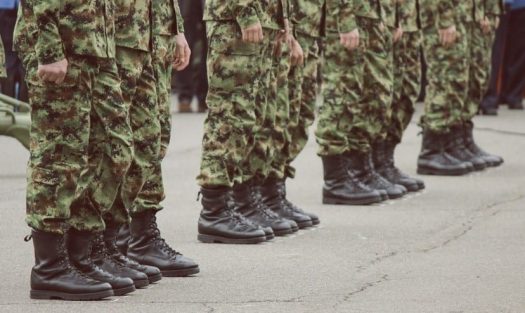
Pixabay [Military Steps Security Protection by george_nick, February 14, 2016, CC0]
Meet Dr. Thomas Britt
Dr. Thomas Britt was a Captain in the Army whose responsibility was to evaluate soldiers returning from Desert Storm during the late 1990s. Utilizing a variety of screening instruments, Britt and his colleagues sought to determine if returning soldiers suffered from medical or psychological health problems and designated certain cutoff scores which, when surpassed, indicated the need for an individual to speak to a medical or psychological professional (Caudle, 2018).
The “Loony” Line
Britt quickly noticed the presence of stigma associated with being sent to speak to a psychological professional. The peers and subordinates of individuals who were recommended for psychological intervention often referred to them as being in the “loony line” with the thought that they must be “crazy” and would likely no longer be fit for combat (Caudle, 2018). These observations led to Dr. Britt’s interest in the stigma surrounding mental health in the military and the challenges military personnel face that prevent them from seeking necessary mental health treatment.
The Effects of Stigma
Britt, Jennings, Cheung, Pury, and Zinzow (2015) indicate that active-duty military personnel are often reluctant to seek needed treatment for mental health problems for reasons similar to those reported by civilians. More specifically, the perception that others will think of them negatively due to stigma resulting in decreased feelings of self-worth. However, the military population also experiences unique barriers due to the preference of military personnel to handle their own issues and to “tough it out” (Britt et al., 2015; Caudle, 2018). Interestingly, Britt et al. (2018) later found that stigma associated with a soldier’s internalized perception of peers who seek mental health treatment may influence treatment-seeking decisions more than concerns about perceptions of stigma from others.
These findings provide evidence that while military personnel’s views on mental illness have certainly improved since the days of General George C. Patton’s questionable method of handling shell-shocked soldiers in the 1940’s, there are still remnants of stigma despite valiant attempts to support the mental health needs of military personnel (Caudle, 2018). According to Britt, “there is this kind of sense that the climate has improved, and it probably has, but we saw in our qualitative research… that this stigma is alive and well.” (Caudle, 2018). In response, Dr. Britt is involved in projects aimed at applying academic research to create training programs with the end goal of overcoming stigma and changing the way in which military units view mental health treatment-seeking.
Want to Learn More?
More information on Dr. Britt, his team, and his current and past projects can be found here:
http://twbritt.people.clemson.edu/
References
Britt, T. W., Jennings, K. S., Chueng, J. H., Pury, C. L., & Zinzow, H. M. (2015). The role of different stigma perceptions in treatment seeking and dropout among active duty military personnel. Psychiatric Rehabilitation Journal, 38, 142-149. doi: http://dx.doi.org/10.1037/prj0000120
Caudle, N. (2018). When a warrior can’t go it alone. Glimpse Magazine, Clemson University. Retrieved from: http://glimpse.clemson.edu/6072/
This post was written by a member of the OneOp Family Development Team. The Family Development team aims to support the development of professionals working with military families. Find out more about OneOp Family Development team on our website, Facebook, and Twitter.














